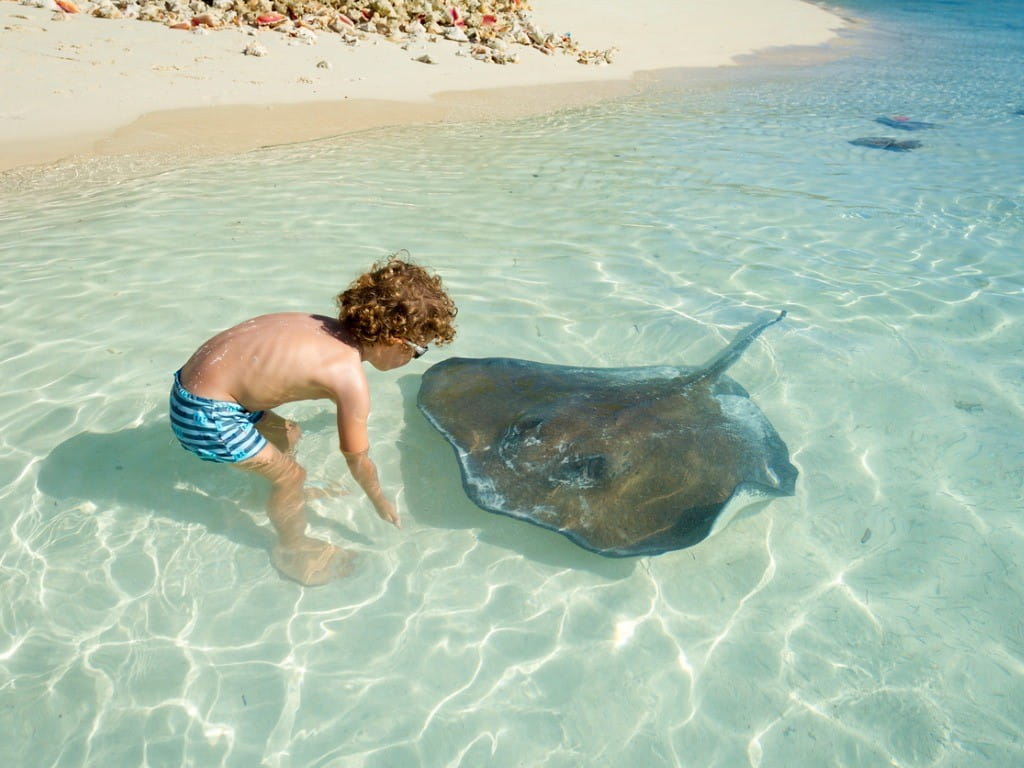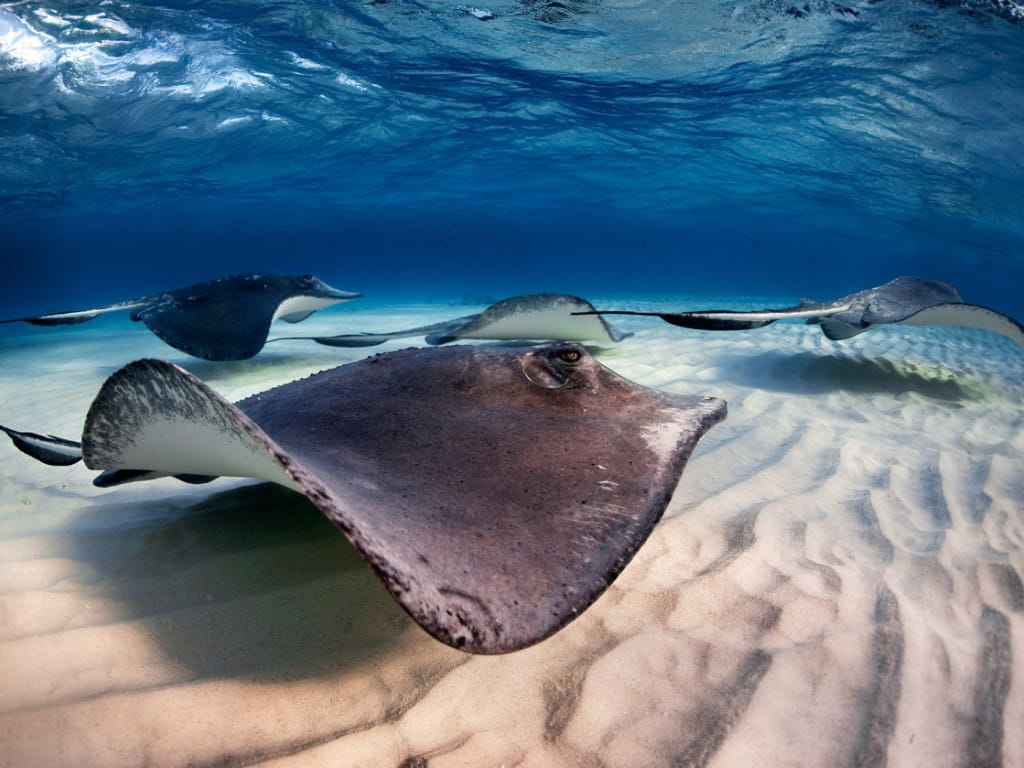Stringray Injuries: Prevention and Treatment

The Bottom Line
Stingrays have long, thin, whip-like tails equipped with one to three barbed venomous spinal blades. Although they are generally shy, they may strike when unintentionally stepped on. Their venom causes intense pain, but the main risk of a stingray injury is the puncture wound. Hot water immersion and good wound care are central to managing stingray injuries.

The Full Story
The stingray has a fierce reputation and is best known for its infamous tail – long, thin, and whip-like with one to three barbed venomous spinal blades. In Greek mythology, Odysseus was killed when his son Telegonus unintentionally stabbed him using a spear tipped with the spine of a stingray. In 2006, television personality and animal activist Steve Irwin, best known as The Crocodile Hunter, died after being pierced in his chest by a stingray. Stingrays pose a threat to fishermen and beachgoers. Every year, about 1,500-2,000 stingray injuries are reported in the US.
Contrary to its reputation, the stingray is a shy and even gentle creature that would rather swim away than strike. It reserves its stinger for its predators – sharks and other large carnivorous fish. It attacks people only when it feels directly threatened, often when it's unintentionally stepped on.
Stingrays are flat and can vary in size from several inches to 6.5 ft. in length and weigh up to 800 lbs. Their wing-like fins create ripples in the water as they swim. There are 11 species of stingrays found in the coastal waters of the US. Their flat bodies and gray color allow them to be camouflaged on the sea floor, where they move slowly to forage for their prey (small fish and crustaceans like crabs and sea snails). Interestingly, a stingray cannot see its prey because its eyes are on the upper side of its body, while its mouth and nostrils are on the underside.
The dangerous part of a stingray is its infamous tail. The spinal blade is also known as the stinger or barb. This stinger is covered with rows of sharp spines made of cartilage and is strong enough to pierce through the skin of an attacker. Not only does the puncture itself cause injury and pain, but the stinger also releases a complex venom, which leads to intense pain at the puncture site. Uncommon effects of the venom include headaches, nausea and vomiting, fainting, low blood pressure, arrhythmias of the heart, and even seizures.
The most common sites of human envenomation are the legs and feet, which makes sense because the most common reason for envenomation is a swimmer unintentionally stepping on a stingray. The envenomation is often limited to severe pain that is relieved when the area is submerged in hot water. However, complications such as infection, serious bleeding, or physical trauma can occur. Part of the spine can also remain embedded in the tissue and require medical intervention to remove it. Death is extremely rare and results not from the venom but from the puncture wound itself if it is in the chest, abdomen, or neck. Death from serious infections like tetanus has also been reported.
Treatment of stingray injuries starts with first aid. Because the puncture is often deep and considered dirty, there is high risk of infection. It's important to wash and disinfect the area immediately and obtain a tetanus vaccine or booster if needed. The wound should be inspected for any retained spines. The standard treatment for the pain is hot water immersion. Medical evaluation and treatment in a hospital is necessary if there are any retained spines in the wound, if the puncture is deep, or if it involves the chest, abdomen, or neck.
The best way to prevent being stung by a stingray is to avoid stepping on it when in the ocean by shuffling through the sand rather than lifting your feet and walking normally (commonly referred to as the "stingray shuffle"). This will warn a stingray of your approach, and it will likely swim away. A pole or stick can also be used ahead of your feet. Divers should be cautious and avoid swimming close to the sea floor. It is also important to know where stingrays are and never provoke them.
If you have a stingray injury, check the webPOISONCONTROL® online tool for guidance or call Poison Control at 1-800-222-1222.
Serkalem Mekonnen, RN, BSN, MPH
Certified Specialist in Poison Information
Poisoned?
Call 1-800-222-1222 or
Prevention Tips
- To avoid unintentionally stepping on a stingray, shuffle or drag your feet along the sea floor rather than lifting your feet and walking normally (do the "stingray shuffle").
- Divers should avoid swimming too close to the sea floor.
- Fishermen who unintentionally catch a stingray should not attempt to disentangle it from the net or fishing line.
- Never provoke a stingray.
This Really Happened
A 47-year-old Danish man was stung on his left ankle by a stingray while he was vacationing on the west coast of Africa. He was stung while walking in shallow waters about 10 ft. from the beach. He immediately experienced intense pain in his left ankle, and he limped to shore. A local sailor repeatedly attempted to suck out the venom with his mouth. He also brought an unknown plant root, chewed it, and applied it to the wound with a compression band.
The pain gradually lessened over the course of a few hours. The plant root and compression band were removed. On the fourth day following the injury, the man developed a high fever along with shivering. The wound had become infected. He was started on oral antibiotics, but the wound did not get better – it was red, swollen, and necrotic. He was switched to intravenous antibiotics and was eventually flown back to Denmark for continued medical treatment.
The wound was surgically cleaned. Samples of the tissue indicated a mixed infection with bacteria usually found in the human mouth. The wound slowly healed, and the man was able to return to work 3 months after the incident. (From Hønge et al.)
For More Information
References
Stingrays [internet]. Washington: National Geographic; 2018 Sep 24 [cited 2020 Feb 28].
Poisoned?
Call 1-800-222-1222 or
Prevention Tips
- To avoid unintentionally stepping on a stingray, shuffle or drag your feet along the sea floor rather than lifting your feet and walking normally (do the "stingray shuffle").
- Divers should avoid swimming too close to the sea floor.
- Fishermen who unintentionally catch a stingray should not attempt to disentangle it from the net or fishing line.
- Never provoke a stingray.
This Really Happened
A 47-year-old Danish man was stung on his left ankle by a stingray while he was vacationing on the west coast of Africa. He was stung while walking in shallow waters about 10 ft. from the beach. He immediately experienced intense pain in his left ankle, and he limped to shore. A local sailor repeatedly attempted to suck out the venom with his mouth. He also brought an unknown plant root, chewed it, and applied it to the wound with a compression band.
The pain gradually lessened over the course of a few hours. The plant root and compression band were removed. On the fourth day following the injury, the man developed a high fever along with shivering. The wound had become infected. He was started on oral antibiotics, but the wound did not get better – it was red, swollen, and necrotic. He was switched to intravenous antibiotics and was eventually flown back to Denmark for continued medical treatment.
The wound was surgically cleaned. Samples of the tissue indicated a mixed infection with bacteria usually found in the human mouth. The wound slowly healed, and the man was able to return to work 3 months after the incident. (From Hønge et al.)
